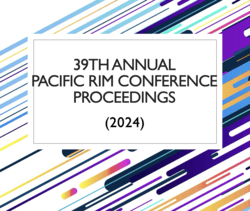The Fatigue in Educational Contexts Survey (FEC): Elevating, Empowering, and Engaging Deaf and Hard of Hearing Students
Main Article Content
Keywords
Deaf/Hard of Hearing, Fatigue assessment, Educational contexts
Abstract
Currently, there are no measures of fatigue that are inclusive and representative of the diverse population of Deaf or Hard of Hearing (DHH) students in schools. Further, the few fatigue surveys that are available focus on workplace or injury related fatigue and are not designed for dual-language users (spoken language and signed language). Without an inclusive assessment tool, students who are) DHH are not able to adequately advocate for or access proper resources to mitigate fatigue in the classroom. Classrooms comprise an ongoing array of cognitive, visual, auditory, and attentional demands. Students who are DHH must navigate these auditory and visual demands for up to six hours a day, five days a week. The increased effort and exertion needed to learn contributes to greater levels of cognitive, social emotional and physical fatigue. Fatigue in educational settings for students who are DHH is poorly understood by both students and educators. The lack of understanding surrounding hearing fatigue creates barriers for students to access resources that are known to minimize fatigue. Consequently, students often do not recognize fatigue symptoms or internalize the causes. The misunderstanding of fatigue symptoms leaves students with limited coping strategies, and can have serious consequences on their learning and academic success. Teachers frequently mistake ineffective coping behaviors as a lack of motivation or laziness, and often fail to recognize the importance of educational supports moderating cognitive, auditory, and visual exertion. Fatigue has a lasting impact on academic, social-emotional, and vocational outcomes for students who are deaf. Inclusive assessment tools will increase awareness of fatigue contributors and in turn help to mitigate negative life outcomes. Thus, our goal is to provide a means for DHH students and their educational team to understand the impact of fatigue, to advocate for appropriate supports such as strategies and programs, in order to moderate fatigue in educational contexts. This paper discusses the first and second phases of this research program, designing and pilot testing the Fatigue in Educational Contexts (FEC) survey. This survey, describes, and interprets the presence and intensity of fatigue, and informs alleviation approaches. The FEC will provide a means for DHH students and their educational team to understand the impact of fatigue, to advocate for appropriate supports, and to moderate fatigue in educational contexts.
References
Bess, F. H., & Hornsby, B. W. (2014b). The complexities of fatigue in children with hearing loss. Perspectives on Hearing and Hearing Disorders in Childhood, 24(2), 25-39. https://doi.org/10.1044/hhdc24.2.25
Bess, F. H., Davis, H., Camarata, S., & Hornsby, B. W. (2020). Listening-related fatigue in children with unilateral hearing loss. Language, Speech, and Hearing Services in Schools, 51(1), 84-97. https://doi.org/10.1044/2019_lshss-ochl-19-0017
Davis, H., & Hornsby, B. (2023). Listening-related fatigue in Deaf and hard of hearing students: Understanding and managing the "fatigue factor." The Volta Review, 123(1), 21-34.
Goldberg, L. R., & Richburg, C. M. (2004). Minimal hearing impairment: Major myths with more than minimal implications. Communication Disorders Quarterly, 25(3), 152-160. https://doi.org/10.1177/15257401040250030601
Hayward, D. V., Ritter, K., Grueber, J., & Howarth, T. (2013). Outcomes that matter for children with severe multiple disabilities who use cochlear implants: The first step in an instrument development process. Canadian Journal of Speech-Language Pathology & Audiology, 37(1).
Hornsby, B. W. (2013). The effects of hearing aid use on listening effort and mental fatigue associated with sustained speech processing demands. Ear and Hearing, 34(5), 523-534. https://doi.org//10.1097/aud.0b013e31828003d8
Hornsby, B. W., Werfel, K., Camarata, S., & Bess, F. H. (2014). Subjective fatigue in children with hearing loss: Some preliminary findings. American Journal of Audiology, 23(1), 129–134. https://doi.org/10.1044/1059-0889(2013/13-0017)
Hornsby, B. W., Davis, H., & Bess, F. H. (2021). The impact and management of listening-related fatigue in children with hearing loss. Otolaryngologic Clinics of North America, 54(6), 1231-1239. https://doi.org/10.1016/j.otc.2021.07.001
Hornsby, B. W., Gustafson, S. J., Lancaster, H., Cho, S. J., Camarata, S., & Bess, F. H. (2017). Subjective fatigue in children with hearing loss assessed using self-and parent-proxy report. American Journal of Audiology, 26(3S), 393-407. https://doi.org/10.1044/2017_aja-17-0007
Hicks, C. B., & Tharpe, A. M. (2002). Listening effort and fatigue in school-age children with and without hearing loss. Journal of Speech, Language, and Hearing Research, 45(3), 573–584. https://doi.org/10.1044/1092-4388(2002/046)
McGarrigle, R., Munro, K. J., Dawes, P., Stewart, A. J., Moore, D. R., Barry, J. G., & Amitay, S. (2014). Listening effort and fatigue: What exactly are we measuring? A British Society of Audiology Cognition in Hearing Special Interest Group ‘white paper’. International Journal of Audiology, 53(7), 433-445. https://doi.org/10.3109/14992027.2014.890296
Michielsen, H. J., De Vries, J., Van Heck, G. L., Van de Vijver, F. J., & Sijtsma, K. (2004). Examination of the dimensionality of fatigue. European Journal of Psychological Assessment, 20(1), 39-48. https://doi.org/10.1027/1015-5759.20.1.39
Rohatyn-Martin, N., & Hayward, D. V. (2016). The challenge of fatigue for students who are Deaf or hard of hearing in inclusive classrooms. International Journal of Learner Diversity & Identities, 23(3), 23-31. https://doi.org/10.18848/2327-0128/cgp/v23i03/23-31
Tharpe, A. M. (2008). Unilateral and mild bilateral hearing loss in children: Past and current perspectives. Trends in Amplification, 12(1), 7-15. https://doi.org/10.1177/1084713807304668


